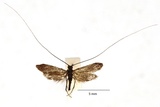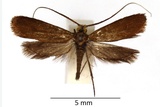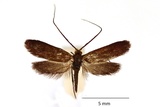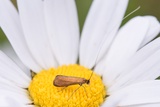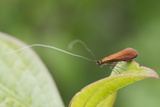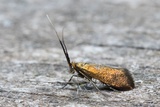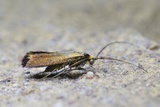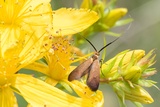Adela violella ([Denis & Schiffermüller], 1775) Species
Last modified: Dec. 16, 2025, 2:27 p.m.
A rare and local species throughout Belgium.
Details
- Classification
- Family: Adelidae > Subfamily: Adelinae > Genus: Adela > Species: Adela violella
- Vernacular names
- Hertshooilangsprietmot (NL), Johanniskraut-Langhornmotte (DE)
- Synonyms
- Adela tombacinella (Herrich-Schäffer, 1855)
- First mention in Belgium
- De Sélys-Longchamps E. 1844. Énumération des insectes Lépidoptères de la Belgique. — Mémoires de la Société royale des Sciences de Liége 2: 1–35. On page 24 (as Adela violella ? Wv.). view page
- Status
-
Native
Distribution
Imago
Wingspan 10–14 mm. Forewing unicolourous reddish-brown with coppery hue. Head ochreous yellow with some mixed black hairs in the male, ochreous yellow in the female. Antennae very thin and 2.5 times the length of the forewing in the male, thickened in the basal half and 1.5 times the length of the forewing in the female.
Caterpillar
Yellowish white; head and prothoracic plate dark brown, almost black; mesothoracic plate brown and metathoracic plate light brown.
Case
Oval case with more or less parallel sides, sometimes tapering towards the end, 7–9 mm long, constructed from dry plant pieces which are cut into more or less crescent-like particles and glued together with sand or detritus. The first case is constructed in the flower of the food plant using the excrements of the larva.
Bionomics
Oviposition in the seed capsules of different species of Hypericum. The larva lives on the flowers and seeds of the food plant where it consumes both the fresh, greenish new leaves or the dry, dead leaves of the plant on which the eggs were laid. Hibernation as a larva, but in different stages of development. Perhaps some caterpillars need two years for their development. Some hibernating larvae crawl to 10 cm deep in the soil while others remain amongst the detritus on the soil. They still feed on detritus in early springtime. Pupation in early spring.
The adults are active in the sunshine. They have been observed feeding mainly on plants with white flowers like Leucanthemum vulgare and Achillea millefolium.
Flight periods
The adults fly in one generation a year from June to early August.
Observed on
- Host plant (species):
- Hypericum perforatum and Hypericum hirsutum
The larva lives on the flowers and seeds of Hypericum perforatum.
Habitat
Different kinds of habitats as long as there are extended stands of Hypericum, preferably at forest edges or on open places inside forests. Both rather dry and warm habitats as cool and wet biotopes are accepted.
